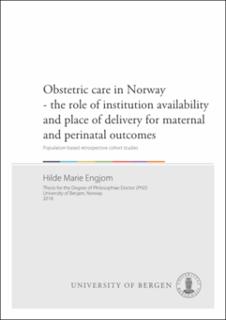| dc.contributor.author | Engjom, Hilde Marie | en_US |
| dc.date.accessioned | 2020-01-15T13:40:04Z | |
| dc.date.available | 2020-01-15T13:40:04Z | |
| dc.date.issued | 2018-03-15 | |
| dc.identifier.isbn | 978-82-308-3822-8 | en_US |
| dc.identifier.uri | https://hdl.handle.net/1956/21286 | |
| dc.description.abstract | Background: Obstetric care in midwife-led institutions may be more cost-effective and reduce the number of interventions during labour. On the other hand, large obstetric institutions may offer more technologically advanced and specialised care. Knowledge of how availability of and access to different types of obstetric institutions impact maternal and perinatal clinical outcomes in a high-income context is lacking. Aims: The aim of this thesis was to assess availability of and access to obstetric institutions in Norway during recent decades and to assess perinatal and maternal clinical outcomes by travel time to institution and place of birth. The first study assessed changes in travel time on a population level, the risk of unplanned birth outside institution over time, as well as the risk of maternal morbidity. The second study aimed to assess the association of mother’s travel time to an obstetric institution and place of birth with peripartum perinatal mortality. The aim of the third study was to assess risk of eclampsia and HELLP syndrome by the mother’s travel time to an obstetric institution and place of delivery. Material and methods: The studies were conducted using population-based data from Norway. The primary data source was the Medical Birth Registry of Norway (MBRN), and we included births from 1979 to 2009. The mother’s unique national identification number was used to link births in the MBRN to her registered address. Statistics Norway provided geographic coordinates linked to National Registry addresses for two ecological cross-sectional studies and two cohort analyses. We also used the mother’s unique identification number to link births to their mother in a sibling-structure to assess clinical outcomes in subsequent pregnancies. Obstetric institutions were categorised by function and annual number of births. Availability of and access to obstetric institutions was based on the woman’s travel time to the nearest obstetric institution. Travel time was estimated using geographic information systems software combined with the Norwegian digital road database. Population proportions and risks were assessed using cross-tables. Logistic regression and generalized linear models were used to calculate odds ratios and relative risks with 95% confidence intervals and to adjust for confounders. Travel time ≤ 1 hour was used as reference for all travel time analyses. Multilevel regression models were used to account for clustering by several births to the same mother and by births in the same institution. Sibling structures with the mother as the observation unit were used to assess outcomes in successive pregnancies. Results: In the first study, we found a 10% increase in the proportion of women of reproductive age living outside the 1-hour travel zone to all obstetric institutions and to Emergency Obstetric and Newborn Care (EmONC) institutions from 2000 to 2010. On a national level, the risk of unplanned birth outside institution doubled from 1979- 83 to 2004-09 and the differences between counties increased. The risk of maternal morbidity increased by 40% from 2000 to 2009 on a national level, with increasing regional differences. The second study showed that unplanned birth outside institution was associated with higher risk of peripartum perinatal death (death during delivery or within the first 24 hours). Women with travel time exceeding one hour to any obstetric institution had higher risk of unplanned birth outside institution compared to women with less than 1 hour travel time. On a population level, 2 % of peripartum perinatal deaths could be attributed to unplanned birth outside institution. In the third study, we found that nulliparous women who had to travel more than one hour to any obstetric institutions had a 50 % higher risk of eclampsia or HELLPsyndrome. These complications occurred in all categories of obstetric institutions. Women with risk factors such as preeclampsia or previous preeclampsia delivered in the larger EmONC institutions. Deliveries prior to 35 gestational weeks were also referred to the largest EmONC institutions. Women with previous preeclampsia had a higher risk of recurrence, but the majority of parous women with eclampsia or HELLP did not have previous preeclampsia. Conclusion: Access to obstetric institutions and skilled birth attendance play an important role to reduce the risk of adverse clinical maternal and fetal outcomes. In planning or evaluating changes in the obstetric healthcare structure, associated changes in the distribution of benefits and burdens should be considered. Further work must aim at assessing risk of a wider range of maternal complications as well as neonatal morbidity and mortality. | en_US |
| dc.language.iso | eng | eng |
| dc.publisher | The University of Bergen | eng |
| dc.relation.haspart | Paper I: Engjom, Hilde Marie; Morken, Nils-Halvdan; Norheim, Ole Frithjof; Klungsøyr, Kari. Availability and access in modern obstetric care: a retrospective population-based study. BJOG: an International Journal of Obstetrics and Gynaecology, 2014;121(3):290-299. The article is available at: <a href="http://hdl.handle.net/1956/8866" target="blank">http://hdl.handle.net/1956/8866</a> | en_US |
| dc.relation.haspart | Paper II: Engjom, Hilde Marie; Morken, Nils-Halvdan; Høydahl, Even; Norheim, Ole Frithjof; Klungsøyr, Kari. Increased risk of peripartum perinatal mortality in unplanned births outside institution: a retrospective population-based study. American Journal of Obstetrics and Gynecology, 2017; 217(2):210.e1-210.e12. The article is available at: <a href="http://hdl.handle.net/1956/17445" target="blank">http://hdl.handle.net/1956/17445</a> | en_US |
| dc.relation.haspart | Paper III: Engjom, Hilde Marie; Morken, Nils-Halvdan; Høydahl, Even; Norheim, Ole Frithjof; Klungsøyr, Kari. Risk of eclampsia and HELLP by travel time to institution and institution category; a population-based cohort study. Pregnancy Hypertension, 2018;14:1-8. The submitted version is available in the main thesis. The published version is available at: <a href="https://doi.org/10.1016/j.preghy.2018.05.005" target="blank">https://doi.org/10.1016/j.preghy.2018.05.005</a> | en_US |
| dc.title | Obstetric care in Norway - the role of institution availability and place of delivery for maternal and perinatal outcomes. Population-based retrospective cohort studies | en_US |
| dc.type | Doctoral thesis | |
| dc.rights.holder | Copyright the author. All rights reserved | |
| dc.identifier.cristin | 1571760 | |
